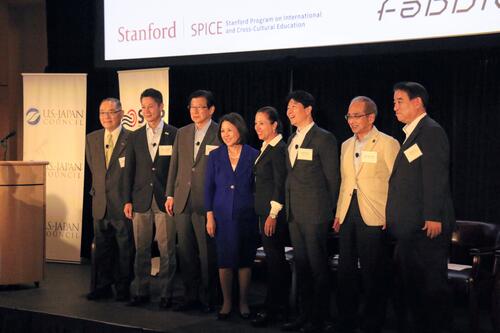Stanford e-Entrepreneurship Japan: Fueling Positive Change Through Empowerment, Purpose, and Connection
The following reflection is a guest post written by Aylie Guyodo Oyama, an alumna and honoree of the Fall 2023 Stanford e-Entrepreneurship Japan Program. Aylie is a disability rights advocate and is currently a student at the British School in Tokyo, Japan.
I am beyond thrilled to pen down my thoughts and gratitude for the incredible learning opportunity I’ve had during the Stanford e-Entrepreneurship Japan (SeEJ) program. My experience has been nothing short of amazing, from the instructors and my fellow classmates to our guest speakers, the teaching methods, and more. All of these elements made my educational journey such an inspiring and meaningful one.
I first joined the program with the aim of deepening my understanding of the world’s issues that have both global and local significance in our lives through the lens of an entrepreneur. It far exceeded my expectations. I learned that the term social is inextricably linked with the concept of entrepreneurship. Most importantly, I developed a sense of global citizenship and responsibility, which has changed the way I see the world and approach different perspectives and solutions. It helped me appreciate how vital it is to live in alignment with what matters most to us as a person, as a member of our community, and as a responsible global citizen. I learned that entrepreneurship is about what you are passionate about in helping others and bringing about positive change. It means recognizing the interconnectedness of our actions with the well-being of communities, the environment, and society at large. This program has instilled in me the importance of ethical decision-making, sustainability, and the pursuit of ventures that prioritize positive contributions to the world and in others’ lives.
The course aligned perfectly with my passion for helping others. Being a disability advocate is something I’m very passionate about. I chose to share my experience of living with a non-apparent disability in the hope that it will help others. I was an aspiring ballet dancer for as long as I can remember. A few years ago, however, I sustained a severe injury, making me rely on a wheelchair and leaving me with a lasting disability. Accessibility became a significant struggle for me. It really changed me completely as a person. This challenging experience provided me with a glimpse into the reality faced by disabled individuals and broadened my perspectives on attitudes and approaches to issues related to disability.
I am therefore on a mission to make a positive impact, foster understanding, support those facing adversity, and improve the lives of disabled individuals for the better. I hope to raise awareness and help flip the narrative toward viewing disability as ability and seeing people with disabilities as contributors to society.
My individual research paper, which is a major component of the SeEJ program, explored disability inclusion and particularly inclusive entrepreneurship as one possible solution and a key pathway to providing equal opportunities and participation for people with disabilities. I am also a big believer in the power of technology and innovation, especially disability tech, and I believe that social innovation can really transform people’s lives, particularly by improving accessibility and social inclusion. This was the central theme of the final group project that my classmates and I chose to work on. We had a lot of fun working as a team to come up with our vision for a more inclusive future and pitch our cutting-edge assistive technology prototype to “investors” to empower the community of visually impaired and blind people and provide them with newfound independence, safety, and confidence in navigating the world.
With the deep opportunities that the SeEJ program has given us, I have come to greatly appreciate the individuality and diversity of others. Working with people of different backgrounds helps to foster deeper interpersonal understanding and collaboration and creates conditions that are conducive to creativity.
Moreover, I really enjoyed the different workshops and group projects, as they were highly interactive and engaging. The step-by-step human-centered design thinking process was such an eye-opener for me. I realized how empathy and collaboration are critical in the process of understanding and meeting the needs of others, as well as prototyping, testing, and getting constant feedback to improve your solutions.
Overall, I am leaving the program with so many powerful insights and a determination to apply those valuable takeaways on my ongoing path to achieving my goals and dreams and growing as a person. One of my favorite inspiring quotes was from Sukemasa Kabayama, one of our guest speakers and co-founder and CEO of Uplift, who gave us this advice: “Be comfortable with the uncomfortable so that we see life as more interesting and richer!” If this resonates with you like it did with me, I enthusiastically recommend the Stanford e-Entrepreneurship Japan program!
To stay informed of SPICE news, join our email list and follow us on Facebook, X, and Instagram.
Read More
High school student Aylie Guyodo Oyama reflects on her transformative educational experience in Stanford e-Entrepreneurship Japan, and on connecting entrepreneurship with her passion for helping others.













 SHCPE 2019 team with Ken-ichi Nakamura, President of the Prefectural University of Hiroshima
SHCPE 2019 team with Ken-ichi Nakamura, President of the Prefectural University of Hiroshima

 Carey Moncaster, Stanford University, and Julia Gooding, BE Education, at the International Association for College Admissions Counseling (ACAC) Conference 2019, London, Canada
Carey Moncaster, Stanford University, and Julia Gooding, BE Education, at the International Association for College Admissions Counseling (ACAC) Conference 2019, London, Canada


